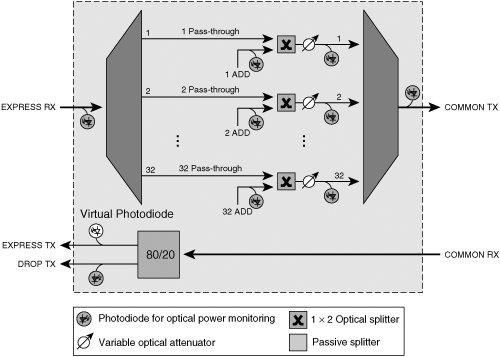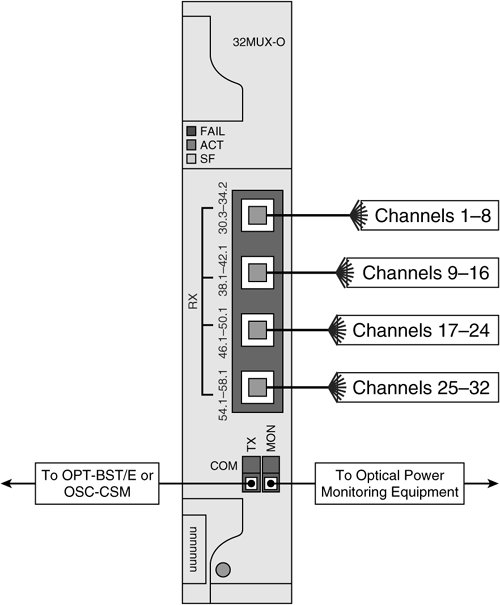32-Channel Multiplexer Cards
| Two types of 32-channel multiplexer cards exist: the 32 MUX-O and the 32 wavelength selective switch (WSS). Each has the general function of accepting 32, 100-GHz-spaced ITU-T wavelength channels and multiplexing them into a common fiber output. 32 MUX-O Multiplexer CardChannel multiplexing is accomplished using an on-board arrayed waveguide grating (AWG). Each of the 32 channel inputs can be sourced from a variety of optical products, each of which might have varied channel output power. For this reason, the optical inputs to the 32-channel multiplexer are equipped with an automatic variable optical attenuator (VOA) to equalize channel power among the 32 channel inputs. This ensures uniform gain distribution for each channel in the case of channel amplification, and also minimizes the risk of interchannel cross-talk. The maximum insertion loss for each input channel, assuming the minimum VOA attenuation, is 8.5 dB. ITU-T wavelength channels are input into the 32 MUX-O card using four MPO ribbon connectors on the front faceplate. Each ribbon connector contains eight transmit pairs for interfacing to a fiber cross-connect or termination panel. The 32 MUX-O is a double-slotted interface card. It can be inserted in the ONS 15454 shelf assembly Slots 15 or 1216. Note The card cannot be inserted in Slots 6 or 17 because it must occupy dual adjacent universal interface slot positions. Figure 9-9 shows the faceplate layout of the 32 MUX-O. Figure 9-9. 32 MUX-O Card Faceplate Diagram 32 WSS Multiplexer CardThe 32 WSS interface unit is used to provide reconfigurable optical add/drop multiplexing (ROADM). With ROADM, any channel(s) within the 32-channel MSTP wavelength system can be added, dropped, or passed through to another DWDM site using software-controlled optical switches. The 32 WSS employs an integrated 80/20 optical splitter to initially drop wavelength channels to the 32-channel demultiplexer unit (covered later in this chapter). In addition to channel multiplexing, the 32 WSS provides the capability to add or pass through any of the 32 ITU-T channels in the MSTP system. This is accomplished using an on-board 2 x 32 AWG, coupled with 32 1 x 2 optical switches. Figure 9-10 details a block diagram of the 32 WSS interface module. Figure 9-10. The 32 WSS Card Block Diagram Each of the 32 channel inputs can be sourced from a variety of optical products, each of which can have varied channel output power. For this reason, the optical inputs to the 32-channel multiplexer are equipped with an automatic VOA to equalize channel power among the 32 channel inputs. This ensures uniform gain distribution for each channel (in the case of channel amplification) and also minimizes the risk of interchannel cross-talk. The maximum insertion loss for each input channel, assuming the minimum VOA attenuation, is 11.3 dB. ITU-T wavelength channels are input into the 32 WSS card using four MPO ribbon connectors on the front faceplate. Each ribbon connector contains eight transmit pairs for interfacing to a fiber cross-connect or termination panel. In addition, six LC-PC-II optical connectors are used on the front faceplate to interface the 32 WSS to other interface cards within the MSTP system. Figure 9-11 details the fiber connections for the 32 WSS. Figure 9-11. The 32 WSS Card Faceplate Diagram The 32 WSS is a double-slotted interface card. It can be inserted in the ONS 15454 shelf assembly Slots 15 or 1216. Note The card cannot be inserted in Slots 6 or 17 because it must occupy dual adjacent universal interface slot positions. Figure 9-11 shows the faceplate layout of the 32 WSS. |
EAN: 2147483647
Pages: 140

